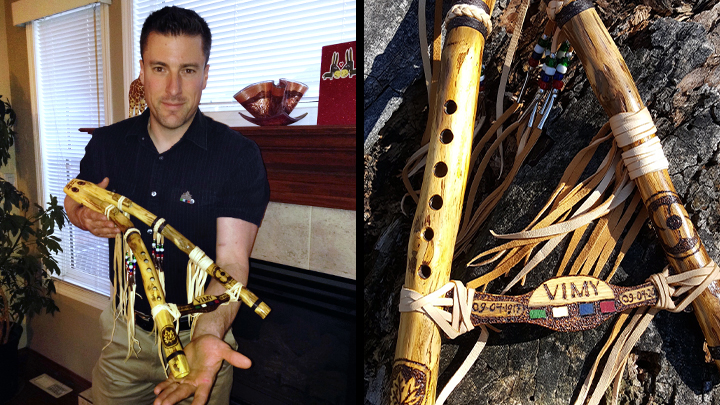
April 4, 2017

On the 100th anniversary of the battle of Vimy Ridge (April 9-12, 1917), former reservist Ryan Mullens, a senior advisor in Talent Development with AHS, is visiting the site in northern France to honour the sacrifice of the 3,600 Canadian soldiers who died there, and whose division ultimately prevailed to wrest the strategic ridge from the enemy. Mullens will perform Amazing Grace on a special flute crafted in oak, taken from trees that were grown from acorns gathered a century ago on the actual battlefield.
Story by Gregory Kennedy
Mighty oaks from little acorns grow, and so will one man’s heartfelt remembrance this weekend when Ryan Mullens plays a very special wooden flute on the Vimy Ridge battlefield on the 100th anniversary of the hard-won victory.
Over four days, from April 9-12, 1917, the nightmarish First World War battle for the escarpment in northern France saw 3,600 Canadian soldiers sacrifice their lives, even as their ultimate triumph forged Canada’s identity in the world.
As the strains of Amazing Grace rise over the still-cratered landscape this Sunday, Mullens, a senior advisor in Talent Management for AHS in Calgary and a former reservist, will be playing a flute rich in symbolism with a unique connection to the conflict.
“I’m humbled by it. It’s a special connection,” says the 35-year-old who served from 2001-2009. “It’s all thanks to a decision made by a soldier 100 years ago just to do something and, in some way, it comes back 100 years later to the battlefield.”
The story of his oak flute begins at Vimy Ridge itself, where Canadian soldier Lt. Leslie Miller collected oak acorns in 1917 from the desolate, shell-scarred landscape, searching for a symbol of life or hope amid the carnage.
After the war, Miller planted the seeds in his hometown of Scarborough, Ont., where they grew into a small grove of nine trees known today as the Vimy Oaks.
When Mullens heard of their existence last fall, he arranged for Ontario craftsman Stephen Rensink to fashion a flute from their sturdy deadfall as a personal act of remembrance — not just for the Vimy fallen, but for three fellow soldiers he knew who lost their lives in Afghanistan.
“Like myself, the soldiers I served with had dreams and aspirations and things they wanted to do — and they wanted to serve Canada — and they gave their lives doing that. Just seeing how hard that was on everyone, on the other soldiers, and especially on their families….” Mullens’ voice trails off into a moment of silence.
“And then you think of a battle like Vimy … 3,600 guys died just in that battle, with another 7,000 wounded … and then you think of the First World War which in which close to 61,000 Canadians died — and the amount of pain that comes with that — and we really need to honour and remember that.”
The Battle of Vimy Ridge was the first instance in which all four divisions of the Canadian Expeditionary Force fought together — and it became a Canadian national symbol of achievement and sacrifice.
As such, the site features a stunning tribute to those men. The Canadian National Vimy Memorial is a soaring twin-towered monument, with a breathtaking design by Walter Allward. It was unveiled in 1936 by King Edward VIII. As a further testament to the sacrifices made, the land on which the monument stands still bears deep scars: wartime tunnels, trench lines, craters and unexploded munitions honeycomb the grounds of the memorial and its cemeteries, which remains largely closed off for public safety.
Mullens’ family also has deep roots with the military.
“My family connection goes back to the First World War; I have two great-grandfathers who served. One was a combat engineer, like myself,” says Mullens.
“My mom often shared memories of her grandfather with me, and we have pictures. I feel especially connected to my great-grandfather Archibald Cripps, the engineer. We share many similarities, and my family says I look more like him than anybody else.”
Mullens is in France now with his father Edward, literally ‘playing’ his respects on his two-pronged instrument.
“It’s a drone flute, kind of like two flutes in one,” he says. “One side plays a constant note, while I play the melody on the other side, so it creates a bagpipe-like sound.”
The flute features glass beads and a ‘Vimy’ nameplate in the four divisional colours, as well as a carved line of poetry from The Stand of Oak, by Penn Kemp: ‘In the slow dream of trees may the men awake who died there.’
“For my dad and I, it’s always been a ‘bucket-list’ thing to go to Europe, to do a battlefield tour, to see these places — and to remember.”
As part of a journey organized by Liberation Tours, father and son will also visit other memorials and battlefields across France and Holland.
“There’s a lot of different emotions,” adds Mullens, who will play softly and gently, both by design … and by necessity.
“The Vimy flute requires finesse. It’s made out of branches. It’s arced. It’s pretty finicky. I have to be really gentle with it. If I overblow it, it will squeal. Some of my other flutes can handle a lot more volume. This one requires a gentle touch.”